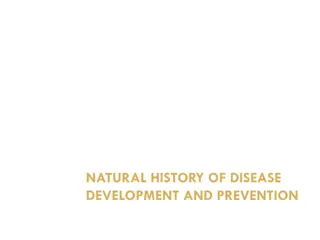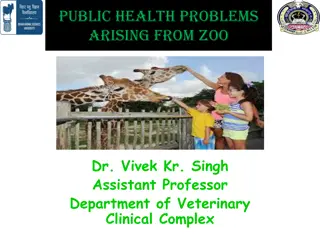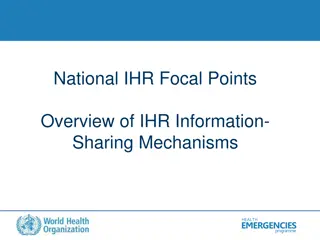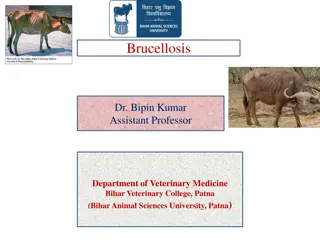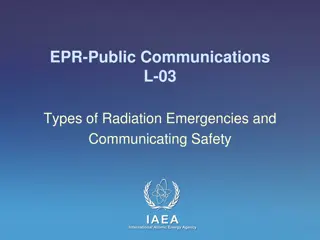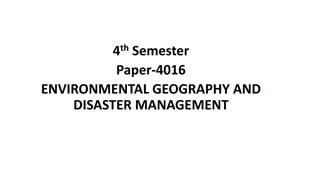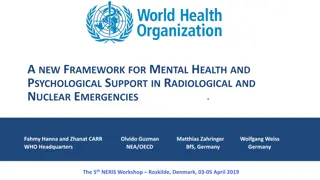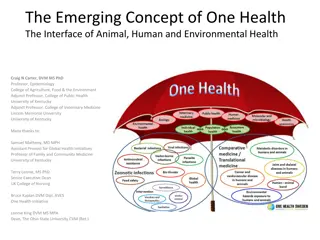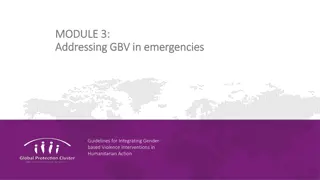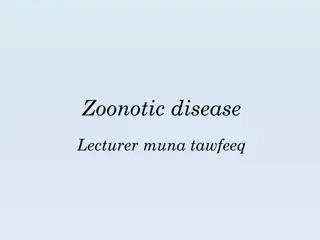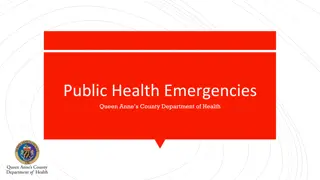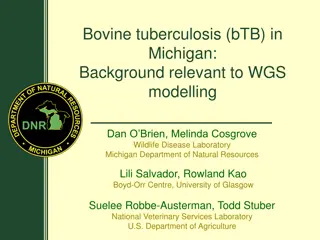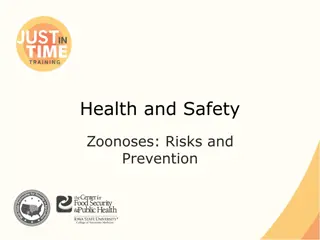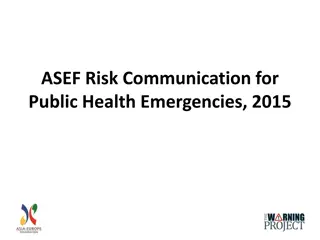Enhancing Zoonotic Disease Risk Communication in Public Health Emergencies
Explore the significance of adopting a One Health approach to zoonotic disease risk assessment and communication in the context of emergency health situations. The session emphasizes core capacities required by the International Health Regulations (IHR) 2005, effective risk communication processes, pillars of risk communication, and domains of Emergency Risk Communication (ERC). Key themes include creating a receptive mindset, utilizing two-way communication, building trust, and engaging communities in risk communication efforts.
Download Presentation

Please find below an Image/Link to download the presentation.
The content on the website is provided AS IS for your information and personal use only. It may not be sold, licensed, or shared on other websites without obtaining consent from the author.If you encounter any issues during the download, it is possible that the publisher has removed the file from their server.
You are allowed to download the files provided on this website for personal or commercial use, subject to the condition that they are used lawfully. All files are the property of their respective owners.
The content on the website is provided AS IS for your information and personal use only. It may not be sold, licensed, or shared on other websites without obtaining consent from the author.
E N D
Presentation Transcript
Adopting a One Health approach to zoonotic disease risk assessment and risk communicationworkshop Rodrigue Barry Rodrigue Barry Session 4, Oct 7th WHO AFRO DAKAR EMERGENCY HUB AFRO DAKAR EMERGENCY HUB WHO HEALTH EMERGENCIES programme 1
Core capacities required by IHR 2005 (national, intermediate and local) In order to set up the IHR, focus was on the main capabilities of the IHR and potential risks The level of preparation of countries to implement the IHR is measured according to these main capacities Annexe 1 8 core capacities L gislation & Politics Coordination Surveillance Response Pr paration level RCCE Human Resources Laboratoiry Risques potentiels Infectious Diseases Zoonotic events Health Security Chemical events Radiological events Events at points of entry RCCE is an essential component of an effective response to public health emergencies HEALTH EMERGENCIES programme
Communication process today Be open during conversations. Help create a receptive mindset Telling the community or individual what to do Using Create Two-Way Communication/ Dialogue messages to communicate Telling the community or individual what to do Listen to concerns to build trust, and thus facilitate understanding of advices HEALTH EMERGENCIES programme
RISKCOMMUNICATION (Pillar) Values Mutual Support Values (socio-cultural to be considered) Technical information (contribution from experts) Mutual Support & Empathy (ability to feel like other are feeling) Credibility (message holder & content) Trust (security feeling) Cr dibility Technical Informations TRUST Dedicated to persons or organization are key to build TRUST Successful risk communication necessarily generates TRUST which leads to community engagement. . HEALTH EMERGENCIES programme
RCCE 05 Domains Internal Coordination & partners for RCCE for Emergency Risk Communication (ERC) RCCE System for Health Emergency Situation Public Communication Perceptions, Rumors & Fake news management (Misinformation) Engagement of the communication with affected communities HEALTH EMERGENCIES programme
Some principles for community engagement 1. Communicate in a timely manner and promote transparency 2. Listen, understand and respect community concerns 3. Plan 4. Ensuring fairness (EQUITY) 5. Realize All of this leads to building trust HEALTH EMERGENCIES programme
Other principles for successful community engagement All communications actions and products aimed at the community must be adapted: 1. level of education 2. Common languages or dialects 3. Channels and trusted stakeholders. HEALTH EMERGENCIES programme
RCCE Before, During, After the Outbreak It helps prepare the community for a possible risk of a cholera epidemic. This communication must take place at several levels: (Before) : National, Health Care Workers, Community; (During) : Communicate on the event, The risk, Actions; (After) : Evaluate the effectiveness of the communication team & Actions implemented, Maintain communication with the community, Learn from previous experiences RCCE is essential at all levels of intervention (preparation, response, monitoring, etc.) RCCE helps to build TRUST among the populations in the health response by managing rumors and misinformation as well as possible. HEALTH EMERGENCIES programme
RUMORS & MISINFORMATION MANGEMENT (Monitoring) RUMORS & MISINFORMATION MANGEMENT Traditional media and social media monitoring Community Radio conversations monitoring Telephone & emergency assistance services Feedback from operational partners, first-line responders & volunteers. Data from surveys and focus group discussions. HEALTH EMERGENCIES programme
What is risk communication? refers the real-time exchange of information, advice and opinions between experts or officials and people who face a threat (hazard) to their survival, health or economic or social well-being. Working definition derived from the IHR working group on risk communication, 2009 Information & Engagement Decision Action 11 Rapid Response Teams Training 11
IMPORTANT TRUST PERCEPTION EMPATHY
Rodrigue Barry Phone : +221 78 010 14 31 (WhatsApp) E-mail :barryr@who.int Twitter : @barryrodB 13


